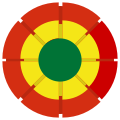- Cockade
-
 A woman fastening a red-and-white cockade to a Polish insurgent's square-shaped rogatywka cap during the January Uprising of 1863–64
A woman fastening a red-and-white cockade to a Polish insurgent's square-shaped rogatywka cap during the January Uprising of 1863–64
A cockade is a knot of ribbons, or other circular- or oval-shaped symbol of distinctive colors which is usually worn on a hat.
Contents
Eighteenth century
In the 18th century, a cockade was pinned on the side of a man's tricorne or cocked hat, or on his lapel. Women could also wear it on their hat or in their hair. A cockade uses distinctive colors to show the allegiance of its wearer to some political faction, their rank, or as part of a servant's livery. In pre-revolutionary France, the cockade of the Bourbon dynasty was all white. In the Kingdom of Great Britain a white cockade was worn by those supporting the restoration of a Jacobite monarchy, while in contrast the established Hanoverian monarchy they were trying to overthrow had one that was all black. But elsewhere and at other times there was more variety.
During the 1780 Gordon Riots in London the blue cockade became a symbol of anti-government feelings and was worn by most of the rioters.
During the American Revolution, the Continental Army initially wore cockades of various colors as an ad hoc form of rank insignia, as General George Washington wrote:
As the Continental Army has unfortunately no uniforms, and consequently many inconveniences must arise from not being able to distinguish the commissioned officers from the privates, it is desired that some badge of distinction be immediately provided; for instance that the field officers may have red or pink colored cockades in their hats, the captains yellow or buff, and the subalterns green.Before long however, the Continental Army reverted to wearing the black cockade they inherited from the British. Later, when France became an ally of the United States, the Continental Army pinned the white cockade of the French Ancien Régime onto their old black cockade; the French reciprocally pinned the black cockade onto their white cockade, as a mark of the French-American alliance. The black-and-white cockade thus became known as the "Union Cockade".
Cockades were later widely worn by revolutionaries and proponents of various political factions in France and its colonies beginning in 1789. Just as they did in the United States a few years before, the French now pinned the blue-and-red cockade of Paris onto the white cockade of the Ancien Régime - thus producing the original Tricolore cockade. Later, distinctive colours and styles of cockade would indicate the wearer's faction—although the meanings of the various styles were not entirely consistent, and varied somewhat by region and period.
Cockades of the Confederate States
Echoing their use when Americans rebelled against England, cockades – usually made with blue ribbons and worn on clothing or hats – were widespread tokens of southern support for secession preceding the American Civil War of 1861–1865.[1]
Cockades of the European military
Also from the 18th century various European states used cockades to denote the nationalities of their military. Ribbon-style cockades were worn on tricornes and bicornes just as the French did, and also on cocked hats and shakoes; metal cockades were worn at the right side of helmets; small button-type cockades were worn at the front of kepis and peaked caps.
During the Napoleonic wars, the armies of France and Russia, had the imperial French cockade or the larger cockade of St. George pinned on the front of their shakos.
In particular, the German Empire used two cockades on each army headgear: one (black-white-red) for the empire; the other for the individual German provinces and kingdoms, which had used their own colors long before. The Weimar Republic removed these, as they might promote faction which would lead to the dissolution of Germany into petty principalities again. In the Second World War, the imperial or Kaiserliche colors of black on the outside, then white, and red on the inside were used on all army caps.
France began the first Air Service in 1909 and soon picked the traditional French cockade as the first national emblem, now usually termed a roundel, on military aircraft. During World War I, other countries adopted national cockades and used these coloured emblems as roundels on their military aircraft. These designs often bear an additional central device or emblem to further identify national aircraft, those from the French navy bearing a black anchor within the French cockade.
Metal cockades continue to be worn to the present day by the armed forces of Germany and Russia.
A list of national cockades
The following is an incomplete list of traditional cockades used by various nations; the colours are listed from the inside out (i.e. left to right). If the air force roundel resembles a cockade but differs from the traditional cockade, the roundel is also specified.
- Argentina - light blue-white-light blue
- Austria - red-white-red
- (until 1918: black-gold)
- Belgium - black-yellow-red
- Bolivia - green-yellow-red
- Bulgaria - red-green-white
- (Bulgarian Air Force roundel: white-green-red)
- Brazil - blue-yellow-green (used as a roundel by aircraft of the Brazilian Navy)
- Chile -
- as worn on peaked cap: blue-white-red with a five-pointed silver star in the middle
- as worn on Pickelhaube: red-white-blue
- Colombia - red-blue-yellow
- Denmark - red-white-red
- (Royal Danish Air Force roundel: white-red)
- Ecuador - red-blue-yellow
- Estonia - white-black-blue
- Finland - white-blue-white
- France - blue-white-red
- (the French navy's Naval Aviation roundel have a black anchor drawn upon the cockade)
- Gabon - green-yellow-blue
- Germany - black-red-gold
- (1871-1945: red-white-black)
- (German Confederation 1848-1871: gold-red-black)
- Great Britain -
- Royal House of Stuart: white
- Royal House of Hanover: black
- (RAF, FAA and AAC roundels: red-white-blue or red-blue)
- Greece - blue-white
- (Hellenic Air Force roundel: blue-white-blue)
- Hungary - red-white-green
- Iceland - blue-white-red-white-blue
- Iran - red-white-green
- Ireland - green-white-orange
- (until 1922: green or sky blue)
- Italy - green-white-red
- Japan - red with white edge (the Hinomaru, worn as a cockade by civilian officials before World War II)
- Mexico - green-white-red
- Monaco - red-white
- Netherlands - orange
- Norway - red-white-blue-white
- Pakistan - White-green-yellow
- Paraguay - blue-white-red
- Peru - red-white-red
- Poland - white-red (but other colours were also used)
- Portugal - green-red
- (from 1820 to 1910: blue-white)
- (until 1820: blue-red)
- Romania - blue-yellow-red
- Russia -
- military - black-orange-black-orange (the Ribbon of Saint George)
- police - red-blue-white
- (Army Air Service roundel until 1918: white-blue-red)
- San Marino - white-blue
- Serbia - red-blue-white
- Spain - red-yellow-red
- Sweden
- civil - blue-yellow
- military - yellow
- during 20th century enlisted men wore a national mark with yellow-blue-yellow, but that was strictly speaking not a cockade.
- Turkey - red-white-red
- United States - (white-blue-red, widely used on A.E.F. aircraft 1917-18. Also, blue with a gold eagle reportedly used late 19th century)
- Uruguay:
- military - blue-white-blue with a red diagonal stripe (Artigas's Cockade)
- police - red-white-blue
- civilian - Cockade of Uruguay - White-blue-white-blue-white-blue-white-blue.
- Venezuela - red-blue-yellow
- Yugoslavia - blue-white-red
-
The Tricolore cockade of France
-
Cockade (escarapela) of Peru
-
Cockade (kokárda) of Hungary
-
Cockade (escarapela) of Argentina
-
Brazilian Army soldiers
-
Cockade (escarapela) of Bolivia
See also
Categories:- Uniforms
- Hats
- Ceremonial clothing
Wikimedia Foundation. 2010.












